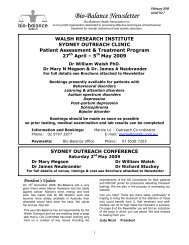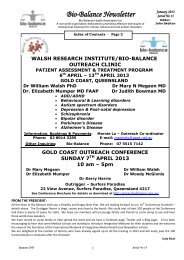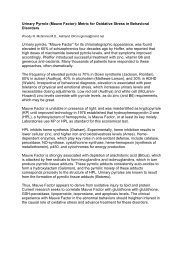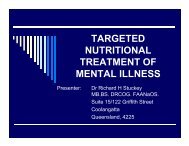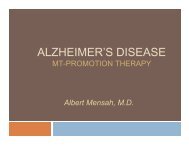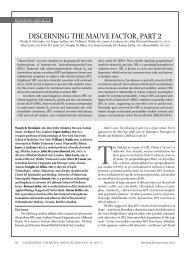Download PDF - Bio-Balance Health
Download PDF - Bio-Balance Health
Download PDF - Bio-Balance Health
- No tags were found...
Create successful ePaper yourself
Turn your PDF publications into a flip-book with our unique Google optimized e-Paper software.
positive response often occurs within the first 7 days of treatment,with 1-2 months usually required for correction of the imbalance.High-copper depressives usually have a history of hyperactivity,tinnitus, and skin sensitivity to metals. Females with this conditionusually have significant PMS and are prone to heightened depressionduring hormonal events such as childbirth and menopause. Theyoften report a worsening of depression after estrogen or multiplevitamins. Treatment focuses on release of excess copper from tissues,promotion of copper excretion, and stimulation of metallothionein (ametal-binding protein). Caution must be exercised due to the tendencyof blood copper levels to rise during the first 10 days of treatment.Many patients report a mild worsening over the first 3 weeks,followed by steady improvement. A total of 60 to 90 days is usuallyrequired to correct this imbalance.Toxic substances which are capable of producing depression includelead, cadmium, mercury, and a wide variety of organic and inorganicchemicals. This syndrome often involves a sudden, prolonged bout ofdepression without apparent reason and without a prior history ofdepression. Treatment varies with the type of toxic material involved,and care must be exercised to avoid flooding the kidneys with toxinsduring the early stages of treatment. Heavy-metal overloads can becorrected quickly by in-hospital chelation, or more slowly usingbiochemical treatment. Organic chemical overloads require liberaluse of antioxidants along with avoidance of the offending substances.In an outcome study of 200 depressive patients treated at the PfeifferTreatment Center, approximately two-thirds reported their antidepressantmedications were no longer necessary after biochemicaltreatment. However a double-blind, controlled study is needed tobetter define treatment efficacy.<strong>Bio</strong>chemical Treatment of Behavior DisordersIn the late 1970’s, Dr. Walsh and co-workers developed a biochemicalclassification system for behavior disorders based on trace-metal



